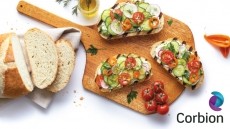Anuga FoodTec 2018
Confusion still surrounds MOSH & MOAH in the food industry
This content item was originally published on www.confectionerynews.com, a William Reed online publication.
The lubricant is registered by NSF as a H1 product for incidental food contact and is IFANCA (Islamic Food and Nutrition Council of America) Halal and Kosher & Parve product certificated. It offers machinery protection at temperatures up to 240C.
Mineral Oil Hydrocarbons
Speaking at Anuga FoodTec in Cologne, Germany, last week (March 23-26) Diana Schneider, chief engineer, ExxonMobil, said global demand for corrugated packaging is rising thanks to the growth of e-commerce, home delivery, and the advantages it has over plastic for suppliers and retailers.
However, disadvantages come in the form of not choosing the right lubricant for corrugated machines that can lead to less downtime and wear and tear.
Typical machinery challenges include high temperatures up to 200°C, exposure to steam, glue spillage and fibre build-up.
Also with increased production of processed foods come more concerns of contamination in the food chain.
“Our current and biggest challenge is the sensitive area of MOSH and MOAH, where we continue to get a lot of questions,” said Schneider.
“There is a lot of confusion in the market.”
What are MOH, MOSH, MOAH & POSH
MOH Mineral Oil Hydrocarbons
MOSH Mineral Oil Saturated Hydrocarbons – paraffins and naphthenes
MOAH Mineral Oil Aromatic Hydrocarbons – ranging from highly alkylated mono-aromatic hydrocarbons, which are generally safe and harmless to poly-aromatic hydrocarbons, some of which can be carcinogenic.
POSH Polyolefin Oligomeric Saturated Hydrocaarbons – oligomers consisting of saturated hydrocarbons from polyolefins and related products.
Food contamination
She said recent media reports suggest new non-standard tests which have used analytical detection methods to demonstrate the presence of traces of MOSH, MOAH and POSH in food substances.
“The tests identify the presence of these and similar synthetic or naturally occurring molecules. They did not demonstrate any correlation between the presence of these substances and any meaningful hazard,” added Schneider.
The tests also did not identify the origin of these traces, which could include packaging, printing inks, recycled paper, wax coatings heating oils and some food additives.
Currently there is no legislation or regulations concerning MOSH/MOAH in food stuffs.
To make informed choices, the European Commission has recommended during 2017-2018 Member States review and monitor MOH content levels in various food substances and where possible the source of the MOH should be investigated.
ConfectioneryNews reported in 2016 chocolate makers can thwart carcinogenic mineral oil contamination in products through regular testing, managing cocoa transportation and adding barrier layers in packaging, according to scientists.
Mineral oil contamination is not just limited to the chocolate industry.
According to SGS, which provides inspection, verification, testing and certification services based in Geneva, Switzerland, mineral oil hydrocarbons from packaging to dry and durable foodstuffs has the potential to contaminate foods such as breakfast cereals, pasta, rice, semolina and baking mixtures.
SGS says there is currently insufficient data to make comparisons between food categories.
ExxonMobil has launched a series of brochures with advice for manufacturers who want to learn more about the topic.













